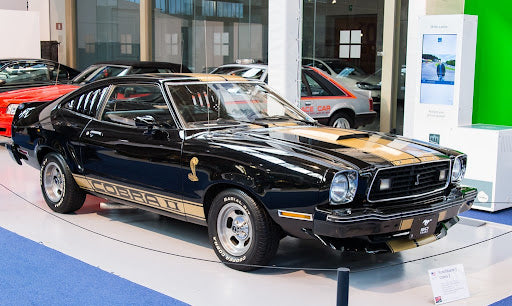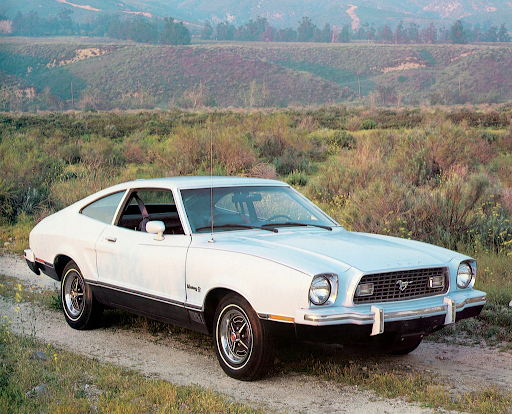
First-generation Mustang was an extremely successful model, so in 1973 Ford wanted to build on the old successes and create a new generation Mustang. Therefore the second generation of Mustang was born for the model year 1974.
There was a fuel crisis at the time, and Ford needed to address this on the new Mustang. After all, first-gen Mustangs were gas guzzlers. So they had to change the size and weight of the car immensely.
That’s why they took Ford Pinto as the base this time around. It was available with a four or six-cylinder engine and in the end, the Mustang II was 4,7 inches narrower and a full 14 inches shorter than its direct predecessor. Depending on the version, it was also 110 lbs to 330 lbs lighter.

Ford launched a new Mustang for 1974 with a big premise of “A small sporty and luxurious car that is considered to be the pioneer of a new class of vehicle”. And indeed the Mustang II was a small revolution.
Lee Iacocca personally launched the Mustang II based on the "Arizona" floor pan of the Pinto in the fall of 1973 as a notchback and fastback coupe with four and six-cylinder engines. It was a smart reaction to the criticism of the exaggerated size of the previous model, increased insurance premiums, stricter emission regulations and the oil crisis,
The drive took over a 2.3-liter in-line four-cylinder or a 2.8-liter V6, neither particularly sporty units. Pony lovers immediately complained about a V8 and the convertible version, which had fallen victim to the safety debate.
The modern front axle design was certainly more remarkable, and it had rack and pinion steering in addition to a subframe. The American car magazine “Motor Trend” then promptly awarded the car with the title “Car of the Year 1974”.
1974 Model Year

The 1974 Mustang II was a total departure from the earlier Mustangs. Much smaller and only available in 2 body styles - a 2-door hardtop and a 3-door hatchback. There were no more convertibles. However, the design contained much of the styling of the first Mustang, such as the long hood with a short tail, the side beads and the front grille.
Mechanically, the Mustang II also differed in many ways from the first Mustang generation. The front axle suspension has been completely redesigned. The front axle springs were relocated between the two knuckles instead of between the upper knuckle and the body.
The front axle frame was designed in such a way that the engine is isolated from the rest of the chassis, this was primarily necessary so that the vibrations of the standard 2.3 liter four-cylinder engine were not transmitted to the bodies.
Rack and pinion steering replaced recirculating ball steering, front disc brakes became standard, as did relocated rear shock absorbers. Standard equipment included a four-speed manual gearbox. In the interior there was a more informative dashboard. Speed, fuel, battery and temperature gauges were standard, as well as non-folding bucket seats.

Two engines were available. The basis was the (140 CUI) 2.3l four-cylinder, which was the first American engine with metric masses. Although it featured a cross-flow cylinder head with overhead camshaft, it only offered a meager 88 hp and not really enough power for a Mustang that weighed almost 3300 lbs.
As an option there was the German-built (171 CUI) 2.8L V6 engine with 105 hp. While it was a nice little machine, even that engine was underpowered for the Mustang II's weight to provide any of the performance that one would expect from the first generation Mustang.
The Mustang II was available in three model variants; basic hardtop, deluxe hardtop 'Ghia' and sporty 'Mach 1' version. The Ghia version replaced the Grande version and was a luxury Mustang.
Ghia is the name of an Italian design studio that Ford took over. The Ghia name was intended to give the Mustang an exclusive European flair. It was upgraded with some equipment like deluxe seat belts, digital quartz clock, and luxury interior items such as vinyl seats, door panels, courtesy lights, velour carpet, rear ashtray and a disguised handbrake lever.

The Mach 1 version came with the larger engine, the 2.8 V6, black accents on the lower half of the body and Mach1 lettering. In order to give the Mach 1 the necessary sportiness, you would also have to order the rally package.
The rally package included a limited slip differential, radial tires with white lettering, reinforced cooling, sports suspension, reinforced front & rear springs, rear anti-roll bar and adjustable shock absorbers.
1975 Model Year

In 1975, Mustang II didn’t really have a huge makeover. The grille received a coarser mesh, which was now practically flush with the front end, the Ghia version received a so-called 'Opera' window to reinforce the luxury image.
The 2.3l four-cylinder remained the standard engine, with the 2.8l V6 as an option, both engines were only available with a four-speed manual gearbox. Ford must have been listening the Mustang enthusiasts because a 302ci V8 engine with 140 hp became available as an option for all Mustang IIs in 1975.
There was a new special Ghia luxury package, available as an option for the Ghia trim. It consisted of a metallic silver paint job, a Normandy silver gray half vinyl roof, side stripes, standing hood ornament, cranberry colored velor seats, console, as well as cloth headlining and sun visors.
The rally package, only available for the 2.8l V6 or the 302 V8 included a slightly reinforced body structure for improved handling. It also contained a limited-slip differential, reinforced cooling, exhaust with chrome-plated tailpipes, digital clock, sports suspension, and stylish sports steel rims with chrome rings.
The new 302ci V8 engine, which is only available with the 3-speed automatic transmission, brought the urgently needed improvement in performance for the Mustang II. Standard accessories were the power steering and the power brakes.
Later in the model year, a so-called MPG (Miles Per Gallon) version of the Mustang II was introduced. This version includes the 2.3l four-cylinder engine, as well as a longer gear ratio of 3.40:1 (standard 3.18:1). The MPG Mustang was developed to optimize fuel consumption. However, this also meant that a new low was reached in terms of driving performance.
1976 Model Year

The 1976 Mustang II saw only a few minor changes. Most of the options and packages were carried over from the 1975 models. However, all base Mustang models with the 2.3l engine were classified as MPG models, thereby emphasizing their economy.
A Cobra II modification package, which was installed by the Motortown Corporation, could now be ordered. It included a front spoiler, rear spoiler, a non-functional hood attachment, and side window louvers with 'snake' emblems. 25,259 Cobra IIs were produced in 1976.
The Cobra II was available in the color combination white with blue or black with gold stripes. All Mustang engines were available on the series, but the 302 V8 was the only engine that promised to live up to expectations of the Cobra II package.
1977 Model Year

For 1977, all 2-door models got a new grille with horizontal braces, and all hatchback models got a black-tinted grille. The hatchback models were all upgraded with standard equipments such as sports steering wheel, sports steel rims and tires with white lettering.
A new interior option was available, which included four-way adjustable seats. The seats were new, not only adjustable in length, but also in height. However, the seat backs remained non-adjustable.
The front spoiler found on the Cobra II models was also now available on all hatchback models as a non-paid option.
The moon roof (glass sunroof) was dropped but the standard metal sunroof remained available. In 1977, the T-Top option was available for the first time, this roof consisted of two removable glass halves, but this option was only available for the hatchback model.
The higher performance requirements were further satisfied by the Mach1 models and the hatchback version with the Cobra II package. Two additional colors for the Cobra stripes in red or green were available for the white Cobra II. All 1977 and later Cobra IIs were built by Ford and in 1977 alone 11,948 Cobra II were produced.
The die-cast aluminum spoked rims were dropped, in exchange there were other aluminum spoked wheels, which were available either in aluminum colors or painted white as an option.
1978 Model Year

1978 was the last year of production for the Mustang II, as well as the Mach 1 version and the Cobra II option package. In the interior, the most visible changes were the conversion of the rear bench seat into two individual seats, instead of the continuous bench seat of the earlier models.
Mechanical changes were made to the 302 V8 engine, which was fitted with either the standard 2-barrel carburettor or a variable valve carburettor. Optional power steering was enhanced with a variable ratio.
The optionally available sports steel rims were now also available in white paint. The forged aluminum wheels could also be ordered in white, but they were still available in aluminum colors.
For $1,277 there was the new King Cobra option, one of the most expensive options for the Mustang since the BOSS 429 option. The 302 V8 engine was standard equipment, as were power steering and power brakes, reinforced springs, adjustable shock absorbers, rear anti-roll bar and spoked alloy wheels. Only 4,960 of the King Cobra model were built.
Protecting 2nd Generation Mustang III

Even today, the second generation Mustang is a highly sought out vehicle and that makes it a classic. It looks good, the technology is simple and solid, the variety offered is enormous. The huge quantities do the rest.
All classic vehicles need extreme care with protection and Mustang is not an exception. If you own one, you are going to need all the protective equipment you can get! That’s where Ford comes in to help. They officially got into a partnership with the Coverking for you to have the best selection of protective equipment.
Let’s start with covers. If you own or thinking about owning a Mustang II we recommend you to get a StormProof Car Cover for outdoor protection and a Satin Stretch Car Cover for indoor garages.
Interior parts of classical vehicles usually need a lot more protection than outside. Think about getting a Molded Carpet Dash Cover and a set of RhinoRide Custom Seat Covers. Also, the sun can seriously damage your classical interior and you answer will be a Custom Fit Sunshield.
Resources
- https://corporate.ford.com/articles/history/mustang.html
- https://en.wikipedia.org/wiki/Ford_Mustang
- https://www.shelby.com/en-us/History
- https://www.motortrend.com/vehicle-genres/ford-mustang-history-generations-models-specifications/
- https://classicponycars.com/history.html
- https://www.evanshalshaw.com/blog/car-legends-legacy-of-the-ford-mustang/
- https://www.caltrend.com/a-spin-thru-the-history-of-the-iconic-ford-mustang/
- https://www.autoevolution.com/ford/mustang/
- https://www.obaugh.com/ford-mustang-history.htm
- https://www.britannica.com/technology/Ford-Mustang
- https://www.topgear.com/car-news/usa/heres-brief-history-ford-mustang
- https://americanhistory.si.edu/collections/search/object/nmah_1293207
- https://www.classicsbeyond.com/history-of-the-mustang
- https://www.businessinsider.com/iconic-versions-ford-mustang-the-worlds-top-selling-sports-car-2020-4
- https://www.autoweek.com/car-life/classic-cars/a1830481/donut-media-shows-rise-and-fall-ford-mustang/
Coverking Links
- https://coverking.com/
- https://coverking.com/pages/recommendation-wizard
- https://coverking.com/products/1976-ford-mustang-car-cover?variant=40328109686946&sub=Shelby%20GT-350&main=car-cover-stormproof
- https://coverking.com/products/1976-ford-mustang-car-cover?variant=40328109686946&sub=Shelby%20GT-350&main=car-cover-satin-stretch
- https://coverking.com/products/1976-ford-mustang-dash-cover?variant=40798145183906&sub=Shelby%20GT-350&main=dash-cover-molded-carpet
- https://coverking.com/products/seat-cover-rhinohide?variant=40326654918818
- https://coverking.com/products/1976-ford-mustang-custom-sunshield
Tankut Basar
Tankut Basar is an ARA (American Rally Assoc.) Racing Driver and an FIA Bronze Category License Holder. His passion for driving began with karting like most racers. He started racing internationally at the age of 22. Tankut loves everything car-related and will keep enjoying the drive until the end.



